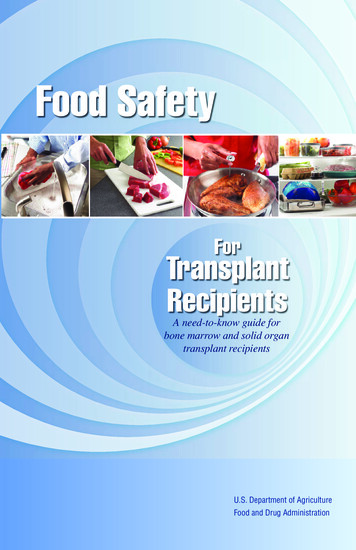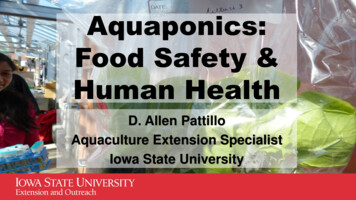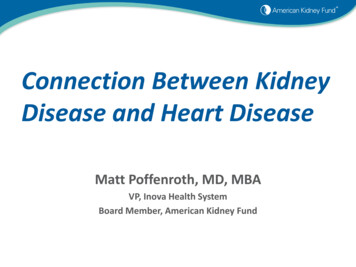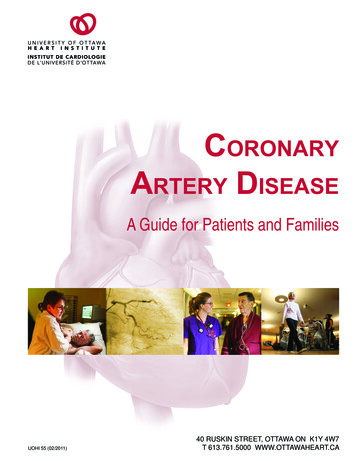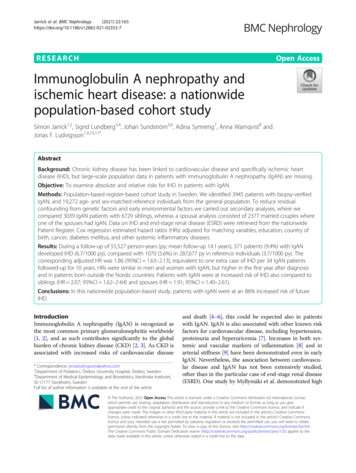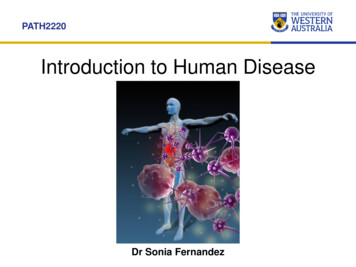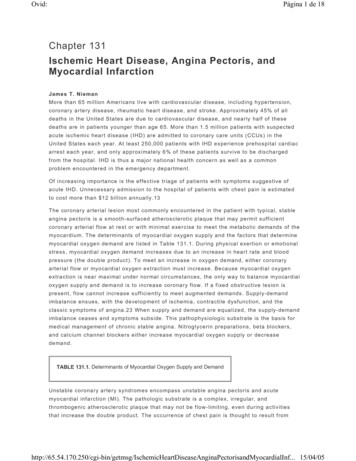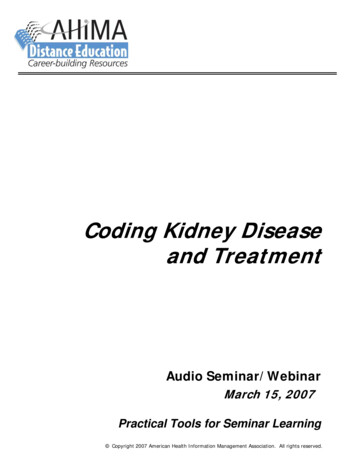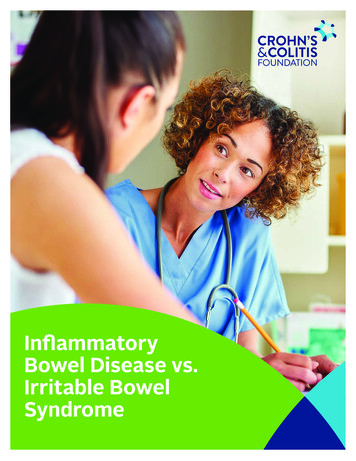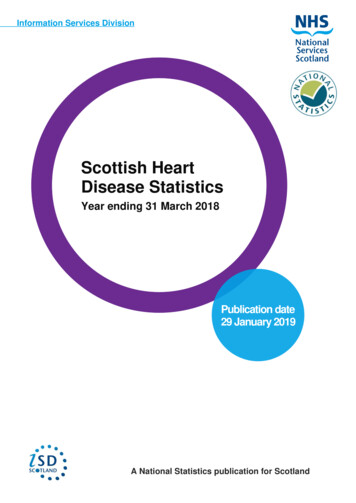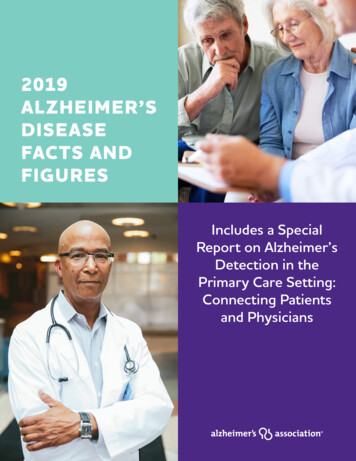
Transcription
FSHN12-04Outbreaks of Foodborne Disease Associated with Fruitand Vegetable Juices, 1922–20101M. D. Danyluk, R. M. Goodrich-Schneider, K. R. Schneider, L. J. Harris, and R. W. Worobo2In response to several outbreaks of illness in the 1990sassociated with raw juices processed at commercialfacilities, the U.S. Food and Drug Administration (FDA)introduced regulation (21 Code of Federal Regulations 120;FDA, 2001) mandating that all 100% fruit/vegetable juicessold wholesale be produced under a Hazard Analysis andCritical Control Point (HACCP) plan. The juice HACCPregulation applies to domestic and imported 100% juiceproducts and has implications for juice producers in countries that export juice to the United States.HACCP plans must have supporting good manufacturingpractices (GMPs) and sanitation standard operatingprocedures (SSOPs). In addition, the regulation requiresjuice processors apply a treatment that results in at least a5-log reduction of the “pertinent microorganism,” whichis defined as “the most resistant microorganism of publichealth significance that is likely to occur in the juice.” Identification of the pertinent microorganism for a particularjuice may be based upon foodborne illness outbreak dataor other appropriate information such as survey or recallreports involving isolation of pathogens from juices or thefruits or vegetables used to produce those juices. Currently,Salmonella is generally accepted as the pertinent pathogenin citrus juices, whereas Escherichia coli O157:H7 as wellas Cryptosporidium parvum are both considered pertinentfor apple juice (FDA, 2001). The juice HACCP regulationapplies to domestic and imported 100% juice products andtherefore has implications for juice producers in countriesthat export juice to the United States.This document is intended to highlight juice-relatedoutbreaks, aid juice processors in the identification of“pertinent microorganisms,” and review the locations, venues of juice preparations, and severity of juice-associatedoutbreaks.Salmonella species on X.L.D. agarPhoto by Nathan Reading CC BY-NC-ND 2.0 http://flic.kr/p/9TtH1V1. This document is FSHN12-04, one of a series of the Food Science and Human Nutrition Department, Florida Cooperative Extension Service, Institute ofFood and Agricultural Sciences, University of Florida. Published January 2012. Visit the EDIS website at http://edis.ifas.ufl.edu.2. M. D. Danyluk, assistant professor, Department of Food Science and Human Nutrition, Citrus Research and Education Center, Florida CooperativeExtension Service, Institute of Food and Agricultural Sciences (IFAS), University of Florida, Lake Alfred, FL 33850. R. M. Goodrich-Schneider, associateprofessor; K. R. Schneider, associate professor; Department of Food Science and Human Nutrition, Florida Cooperative Extension Service, Institute ofFood and Agricultural Sciences (IFAS), University of Florida, Gainesville, FL 32611-0290. L. J. Harris, Cooperative Extension specialist–microbial foodsafety, Department of Food Science and Technology, University of California, Davis, CA 95616. R. W. Worobo, associate professor, Department of FoodScience and Technology, Cornell University, Geneva, NY 14456.The Institute of Food and Agricultural Sciences (IFAS) is an Equal Opportunity Institution authorized to provide research, educational information and other services only toindividuals and institutions that function with non-discrimination with respect to race, creed, color, religion, age, disability, sex, sexual orientation, marital status, nationalorigin, political opinions or affiliations. U.S. Department of Agriculture, Cooperative Extension Service, University of Florida, IFAS, Florida A&M University CooperativeExtension Program, and Boards of County Commissioners Cooperating. Millie Ferrer-Chancy, Interim Dean
Table 1. Outbreaks of human foodborne disease from various microorganisms associated with juices during the period of ses (deaths)bReferencecUnspecifiedTrypanosoma cruzid2004BrazilRetail27SVS, 2005b; Pereira et al., 2009UnspecifiedTrypanosoma cruzi2007BrazilRetail25SVS, 2007b; Pereiraet al., 2009UnpasteurizedS. Typhi1922FranceNRe23 (0)Paquet, 1923UnpasteurizedS. Typhimurium1974USA (NJ)Farm, small retailoutlets296 (0)CDC, 1975UnpasteurizedE. coli O157:H7(suspected)1980Canada (ON)Local market14 (1)Steele et al., 1982UnpasteurizedE. coli O157:H71991USA (MA)Small cider mill23 (0)Besser et al., 1993UnpasteurizedCryptosporidium1993USA (ME)School213 (0)Millard et al., 1994UnpasteurizedC. parvum1996USA (NY)Small cider mill31 (0)CDC, 1997UnpasteurizedE. coli O157:H71996USA (CT)Small cider mill14 (0)CDC, 1997UnpasteurizedE. coli O157:H71996USA (WA)Small cider mill6 (0)FDA, 2001UnpasteurizedE. coli O157:H71996Canada (BC), USA(CA, CO, WA)Retail70 (1)CDC, 1996; Cody et al., 1999UnpasteurizedE. coli O157:H71997USA (IN)Farm6INS DOH, 1997UnpasteurizedE. coli O157:H71998Canada (ON)Farm/Home14 (0)Tamblyn et al., 1999UnpasteurizedE. coli O157:H71999USA (OK)NR25CDC, 2011UnpasteurizedC. parvum2003USA (OH)Farm/Retail144Vojdani et al., 2008UnpasteurizedE. coli O111 and C.parvum2004USA (NY)Farm/Home212Vojdani et al., 2008UnpasteurizedE. coli O157:H72005Canada (ON)NR4LSDEPC, 2005UnpasteurizedE. coli O157:H72007USA (MA)NR9CDC, 2011UnpasteurizedE. coli O157:H72008USA (IA)Fair7CDC, 2011UnpasteurizedE. coli O157:H72010USA (MD)Retail7FDA, 2010HomemadeC. botulinum1993USA (WA)Home1 (0)Buzby and Crutchfield, 1999PasteurizedC. botulinum2006USARetail4CDC, 2006CoconutMilkfVibrio cholerae1991USA (MD)Home/picnic4CDC, 1991; Taylor et al., 1993GuavaUnspecifiedTrypanosoma cruzi2007VenezuelaSchool103 (1)Alarcón de Noya et al., 2010MameyFrozen PureeS. Typhi1999USANR19Katz et al., 2002Frozen PulpS. Typhi2010USARetail9CDC, 2010AçaíAppleCarrot2
TypeProductPathogenaYearLocationVenueCases (deaths)bReferencecUnspecifiedShigella sonnei2002Canada, USA, UK,British West IndiesResort78CDC, 2011Açaí, sugar caneTrypanosoma cruzi2006BrazilNR94 (6)SVS, 2007a; Pereiraet al., 2009Acai, banana,strawberry, sugarcaneHepatitis A2007USA (FL)Food Service3CDC, 2011Mixed Fruit /VegetableClover, sweetpotato leaf, appleAngiostrongyluscantonesisg2001TaiwanHome5Tsai et al., 2004OrangeUnpasteurizedEnterotoxigenic E. coli 1992IndiaRoadside vendor6 (0)Singh et al., 1995UnpasteurizedSalmonella GaminBra,Hartford andRubislaw1995USA (FL)Retail63 (0)CDC, 1995; Cook et al., 1998; Parish,1998UnpasteurizedShigella flexneri1995South AfricaRestaurant14Thurston et al., 1998Mixed FruitUnpasteurizedVirus suspected1996USAFood Service2Parish, 2000UnpasteurizedS. Muenchen1999Canada and USARestaurant423 (1)CDC, 1999UnpasteurizedS. Anatum1999USA (FL)Roadside stand6 (0)Krause et al., 2001UnpasteurizedS. Typhimurium1999AustraliaRetail405 (0)National Centre for Disease Control,1999UnpasteurizedS. Enteritidis2000USA (6 states)Retail and FoodService88Butler, 2000UnpasteurizedSalmonellaTyphimurium andSaintpaul2005USA (23 states)Retail and FoodService152Jain et al., 2009ReconstitutedS. Typhi1944USA (OH)Hotel18 (1)Duncan et al., 1946ReconstitutedHepatitis A1962USA (MO)Hospital24Eisenstein et al., 1963ReconstitutedUnknown1965USA (CA)Football game563Tabershaw et al., 1967ReconstitutedS. Typhi1989USA (NY)Hotel69Birkhead et al., 1993UnspecifiedNorwalk-like virus1991AustraliaAirline3,053Lester et al., 1991Sugar caneUnspecifiedTrypanosoma cruzi2005BrazilRoadside kiosk25 (3)SVS, 2005a; Pereira et al., 2009WatermelonHomemadeSalmonella spp1993USA (FL)Home18 (0)FDA, 19983
/PUFT UP 5able 1 Pathogens abbreviated and associated with outbreaks include S. – Salmonella; E. – Escherichia; C. parvum – Cryptosporidium parvum; C. botulinum – Clostridium botulinum.The number in parenthesFT represents the number of deaths if reported.cReferences for each outbreak appears in the following reference list.dTrypanosoma cruzi is the causative agent of ChBHas EJsease.eNR – Not ReportedfCoconut milk is the liquid that is squeezed from the coconut meat; coconut juice or coconut water is the liquid obtained from a whole coconut when one breaks the shell.gAngiostrongylus cantonensis, also known as rat lungworm, is the major cause of eosinophilic meningitis in the Pacific Islands and southeast Asia.ab4
ReferencesAlarcón de Noya, B., Z. Díaz-Bello, C. Colmenares, R.Ruiz-Guevara, L. Mauriello, R. Zavala-Jaspe, J. A. Suarez, T.Abate, L. Naranjo, M. Paiva, L. Rivas, J. Castro, J. Márques,I. Mendoza, H. Acquatella, J. Torres, and O. Noya. 2010.Large urban outbreak of orally acquired acute Chagasdisease at a school in Caracas, Venezuela. Journal of Infectious Disease 201:1308–1315.Besser, R. E., S. M. Lett, J. T. Weber, M. P. Doyle, T. J.Barrett, J. G. Wells, and M. P. Griffin. 1993. An outbreak ofdiarrhea and hemolytic uremic syndrome from Escherichiacoli O157:H7 in fresh-pressed apple cider. Journal of theAmerican Medical Association 269:2217–2220.Birkhead, G. S., D. L. Morse, W. C. Levine, J. K. Fudala, S. F.Kondracki, H. G. Chang, M. Shaydgani, L. Novick, and P. A.Blake. 1993. Typhoid fever at a resort hotel in New York: Alarge outbreak with an unusual vehicle. Journal of InfectiousDiseases 167:1228–1232.Butler, M. E. 2000. Salmonella outbreak leads to juice recallin Western states. Food Chemical News April 24, 2000.Buzby, J. C., and S. R. Crutchfield. 1999. New Juice Regulations Underway. Food Review. y1999/frmay99f.pdf. AccessedOctober 5, 2011.CDC (Centers for Disease Control and Prevention). 1975.Salmonella typhimurium outbreak traced to a commercialapple cider—New Jersey. Morbidity and Mortality WeeklyReport 24:87–88.CDC. 1991. Cholera associated with imported frozencoconut milk—Maryland. Morbidity and Mortality WeeklyReport 40:844–843.CDC. 1995. Outbreak of Salmonella Hartford infectionsamong travelers to Orlando, Florida. EPI-AID Trip Report95–62.CDC. 1996. Outbreak of Escherichia coli O157:H7 infections associated with drinking unpasteurized commercialapple juice—British Columbia, California, Colorado, andWashington, October 1996. Morbidity and Mortality WeeklyReport 45:975.CDC. 1997. Outbreaks of Escherichia coli O157:H7 infection and cryptosporidiosis associated with drinking unpasteurized apple cider—Connecticut and New York, October1996. Morbidity and Mortality Weekly Report 46:4–8.CDC. 1999. Outbreak of Salmonella serotype Muencheninfections associated with unpasteurized orange juice—United States and Canada, June 1999. Morbidity andMortality Weekly Report 48:582–585.CDC. 2006. Botulism associated with commercial carrotjuice—Georgia and Florida. Morbidity and Mortality WeeklyReport 55:1098–1099.CDC. 2010. Investigation Update: Multistate 0utbreak of)uman Typhoid Fever *nfections "ssociated with 'rozen.amey 1ulp. tml. Accessed October 4, 2011.CDC. 2011. Foodborne Outbreak Online Database(FOOD). x. Accessed October 4, 2011.Cody, S. H., K. Glynn, J. A. Farrar, K. L. Cairns, P. M.Griffin, J. Kobayashi, M. Fyfe, R. Hoffman, A. S. King, J. H.Lewis, B. Swaminathan, R. G. Bryant, and D. J. Vugia. 1999.An outbreak of Escherichia coli O157:H7 infection fromunpasteurized commercial apple juice. Annals of InternalMedicine 130:202–209.Cook, K. A., T. E. Dobbs, W. G. Hlady, J. G. Wells, T. J.Barrett, N. D. Puhr, G. A. Lancette, D. W. Bodager, W. - Toth, C. A. Genese, A. K. Highsmith, K. E. Pilot, L. 'JOFMMJand D. L. Swerdlow. 1998. Outbreak of Salmonella TFSPUZQFHartford infections associated with unpasteurized PSBOHFjuice. Journal of the American Medical Association280:1504–1509.Duncan, T. G., J. A. Coull, E. R. Miller, and H. Bancroft.1946. Outbreak of typhoid fever with orange juice as thevehicle illustrating the value of immunization. AmericanJournal of Public Health 36:34–36.Eisenstein, A. B., R. D. Aach, W. Jacobson, and A. Goldman. 1963. An epidemic of infectious hepatitis in a generalhospital. Journal of the American Medical Association185:171–174.FDA (U.S. Food and Drug Administration). FederalRegister Proposed Rules – 63 FR 20449 April 24, 1998 –HACCP; Procedures for the Safe and Sanitary Processingand Importing of Juice; Food Labeling: Warning NoticeStatements; Labeling of Juice Products. 'FEFSBM 3FHJTUFS "QSJM 63:20449–20486. . Accessed October 4, 2011.5
FDA. Federal Register Final Rule – 66 FR 6137, January19, 2001: Hazard Analysis and Critical Control Point(HACCP); Procedures for the Safe and Sanitary Processingand Importing of Juices. Federal Register: January 19, 200166:6137–6202.FDA. 2010. DHMH Issues Consumer Alert RegardingRecall of Baugher’s Apple Cider. http://www.fda.gov/Safety/Recalls/ucm232878.htm. Accessed October 4, 2011.IFT/FDA (Institute of Food Technologists/U.S. Food andDrug Administration). Outbreaks associated with freshand fresh-cut produce: Incidence, growth, and survival ofpathogens in fresh and fresh-cut produce. In Analysis andEvaluation of Preventive Control Measures for the Controland Reduction/Elimination of Microbial Hazards on Freshand Fresh-Cut Produce, A Report of the Institute of FoodTechnologists for the Food and Drug Administration of theUnited States Department of Health and Human Services,September 30, 2001. eas/SafePracticesforFoodProcesses/ucm091270.htm. Accessed October 4, 2011.INS DOH (Indiana State Department of Health). Summary of Special Disease Outbreak Investigations—1997,Appendix E. http://www.in.gov/isdh/21186.htm. AccessedOctober 5, 2011.Jain, S., S. A. Bidol, J. L. Austin, E. Berl, F. Elson, M. L.Williams, M. Deassy III, M. E. Moll, V. Rea, J. D. Vojdani,P. A. Yu, R. M. Hoekstra, C. R. Braden, and M. F. Lynch.2009. Multistate outbreak of Salmonella Typhimurium andSaintpaul infections associated with unpasteurized orangejuice—United States, 2005. Clinical Infectious Diseases48:1065–1071.Katz, D. J., M. A. Cruz, M. J. Trepka, J. A. Sarez, P. D.Filrella, and R. M. Hammond. 2002. An outbreak oftyphoid fever in Florida associated with an imported fruit.Journal of Infectious Diseases 186:234–239.Krause, G., R. Terzagian, and R. Hammond. 2001. Outbreakof Salmonella serotype Anatum infection associated withunpasteurized orange juice. Southern Medical Journal94:1168–1172.Lester, R , 5 Stewart, Carnie, 4 Ng, BOE 3 Taylor 1991 "JS travel-associated gastroenteritis outbreak, August 1991.Communicable Disease Intelligence 15:292o293.LSDEPC (Laboratory Surveillance Data for EntericPathogens in Canada). Annual summary 2005. http://www.nml-lnm.gc.ca/NESP-PNSME/index-eng.htm. AccessedOctober 4, 2005.Millard, P. S., K. F. Gensheimer, D. G. Addiss, D. M. Sosin,G. A. Beckett, A. Houck-Jankoski, and A. Hudson. 1994.An outbreak of cryptosporidiosis from fresh-pressedapple cider. Journal of the American Medical Association272:1592–1596.National Centre for Disease Control/CommunicableDiseases Network Australia New Zealand, AustralianDepartment of Health and Aged Care. 1999. Salmonellosisoutbreak, South Australia. Communicable Diseases Intelligence 23(3):73.Paquet, P. 1923. Épidémie de fièvre typhoïde: Déterminéepar la consommation de petit citre. Revue d’HygiÒne45:165–169.Parish, M. E. 1998. Coliforms, Escherichia coli, and Salmonella serovars associated with a citrus-processing facilityimplicated in a salmonellosis outbreak. Journal of FoodProtection 61:280–284 Parish, M. 2000. Relevancy of Salmonella and pathogenic E.coli to fruit juices. Proceedings IFU-Workshop “Microbiology.” Fruit Processing 10:246–250.Pereira, K. S., F. L. Schmidt, A. M. A. Guaraldo, R. M.B. Franco, V. L. Dias, and L. A. C. Passos. 2009. Chagas’disease as a foodborne illness. Journal of Food Protection72:441–446.SVS (Secretaria de Vigilância em Saúde do Ministério daSaúde, Brasil). 2005a. Doença de Chagas Aguda relacionadaà ingestão de caldo de cana em Santa Catarina. NotaTécnica, 4 de abril de 2005. http://portal.saude.gov.br/portal/saude/visualizar texto.cfm?idtxt 21270.SVS. 2005b. Doença de Chagas Aguda no municípiode Santana—Amapá. Nota Técnica, 4 de abril de lizar texto.cfm?idtxt 21310.SVS. 2007a. Doença a de Chagas Aguda. Nota Técnica, 9 deoutubro de 2007. a chagas 091007.pdf.SVS. 2007b. Surto de doença de Chagas agudo (DCA) emCoari/Amazonas—abril de 2007. Nota Técnica, 11 de maiode 2007. http://portal.saude.gov.br/portal/saude/visualizar texto.cfm?idtxt 26087. Accessed December 12, 2007.6
Singh, B. R., S. B. Kulshreshtha, and K. N. Kapoor. 1995. Anorange juice borne EJBSSIPFBM outbreak due to enterotoxi genic Escherichia coli. Journal of Food Science and Technology3 :504–506.Steele, B. T., N. Murphy, and C. P. Rance. 1982. An outbreakof hemolytic uremic syndrome associated with ingestion offresh apple juice. Journal of Pediatrics 101:963–966.Tabershaw, I. R., L. L. Schmelzer, and H. B. Bruhn. 1967.Gastroenteritis from an orange juice preparation. Archivesof Environmental Health 15:72–77.Tamblyn, S., J. de Grosbois, D. Taylor, and J. Stratton. 1999.An outbreak of Escherichia coli O157:H7 infection associated with unpasteurized non-commercial, custom-pressedapple cider – Ontario, 1998. Canada Communicable DiseaseReport 25:113–117; discussion 117–120.Taylor, J. L., J. Tuttle, T. Pramukul, K. O’Brien, T. J. Barrett,B. Jolbaito, Y. L. Lim, D. J. Vugia, J. G. Morris, Jr., R. V.Tauxe, and D. M. Dwyer. 1993. An outbreak of cholerain Maryland associated with imported commercialfrozen fresh coconut milk. Journal of Infectious Diseases167:1330–1335.Thurston, H., J. Stuart, B. McDonnell, S. Nicholas, and T.Cheasty. 1998. Fresh orange juice implicated in an outbreakof Shigella flexneri among visitors to a South African gamereserve. Journal of Infectious Diseases 36:350.Tsai, H-C., S. Lee, C-K. Huang, C-M. Yen, E-R.Chen,and Y-C. Liu. 2004. Outbreak of eosinophilic meningitisassociated with drinking raw vegetable juice in southernTaiwan. American Journal of Tropical Medicine and Hygiene71:222–226.Vojdani, J., L. Beuchat, and R. Tauxe. 2008. Juice-associatedoutbreaks of human illness in the United States, 1995through 2005. Journal of Food Protection 71(2):356–364.7
Outbreaks of Foodborne Disease Associated with Fruit and Vegetable Juices, 1922–20101 M. D. Danyluk, R. M. Goodrich-Schneider, K. R. Schneider, L. J. Harris, and R. W. Worobo2 1. This document is FSHN12-04, one of a series of the Food Science and Human Nutrition Depart
